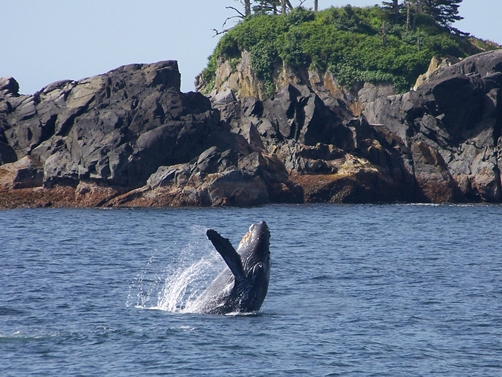Whale Watching 101: View Alaska’s Incredible Gray Whales this Spring

Like many snowbirds in the 49th state, gray whales know how to follow the sun. They spend their winters breeding in the Gulf of California and Baja and their summers feeding in the pristine waters of Alaska. During the spring and fall, gray whales make their 5,000- to 7,000-mile migration between the two locations in pods. April and May are the best months in Alaska to catch sight of these amazing mammals as they travel north along the coast to their feeding grounds in the northern and western Bering Sea and the Chukchi Sea.
Fast facts
Gray whales are huge, comparable in size to your average school bus and weighing in between 30 and 45 tons. They feed by scooping up sediment from the ocean floor and straining tiny creatures through their baleen. Gray whales usually travel between three and five miles per hour but can reach speeds up to 11 miles per hour when in danger. Their life span is generally 50-60 years. During their time in Alaska, gray whales are focused on feeding and have voracious appetites, eating more than one ton of food per day!
Where to watch
In Alaska, the best places to see gray whales are coastal towns such as Seward, Sitka, Ketchikan and Kodiak. Many tour operators offer gray whale watching in the spring and summer. Gray whales are very curious about boats and spend most of their time close to the coast, creating plenty of whale-spotting opportunities and making them very popular among whale-watchers.
What to look for
On a whale-watching tour, your guide will brief you on all of the things to keep your eyes peeled for. When a gray whale surfaces, it can’t be missed! These whales surface often, sometimes raising their gigantic heads above water in what is known as “spy hopping.” It is not uncommon to see a gray whale breach, leaping out of the water and throwing its body back at an angle to create a loud splash. Gray whales’ bodies are covered in barnacles and whale lice, giving their skin a mottled appearance. Unlike the similar-looking humpback whale, gray whales have no dorsal fin. You can often spot their large (10-12 feet wide!) tails emerging from the water as they take a dive, or as they feed in shallow waters.
—
Not able to catch the spring migration this year? You can always come back to Alaska in the fall to catch sight of these amazing creatures as they begin their long southward journey to warmer waters.
Back to Blog